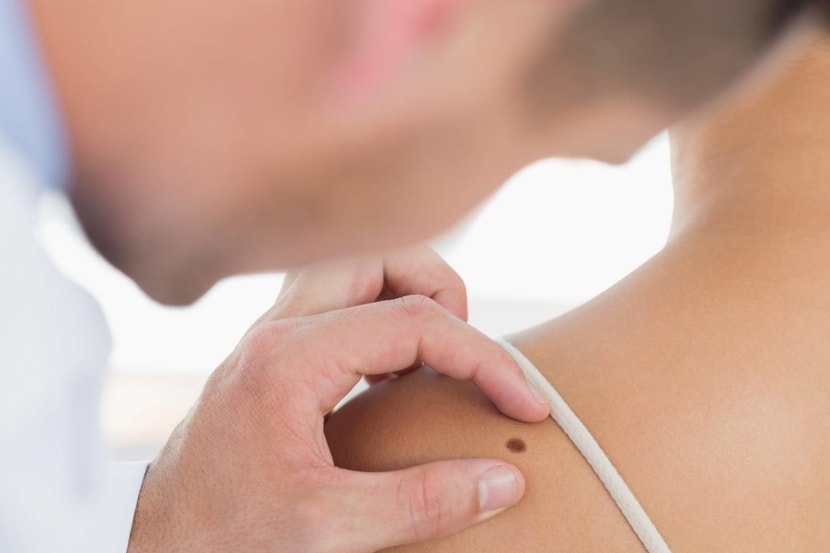Benign Skin Growths & Moles
Everyone has skin growths. The dermatologist is the expert on determining which are harmless and which should receive attention. This article is not a substitute for a medical exam. If you have any serious skin issues or concerns, you need to consult your physician.
Moles
Everyone has moles, from a few to several dozen. Most people think of a mole as being a dark brown spot, but moles have a much wider range of appearance. They can be raised from the skin and very noticeable, or they may contain dark hairs. Having hairs in a mole doesn’t make it more dangerous.
Moles can appear anywhere on the skin, alone or grouped. They usually are brown in color and can be various sizes and shapes. Special cells that contain the pigment melanin cause the brown color. Facial moles are probably are determined before a person is born. Many of those that form in childhood and early adult life are now thought to be due to sun damage. Some may not appear until later in life, but moles that appear after age 50 should be regarded with suspicion. Moles may darken, which can happen after exposure to the sun, pregnancy and sometimes during therapy with certain steroid drugs. Moles can be safely removed for cosmetic or medical reasons.
Blood Moles
These are benign growths that consists of small blood vessels. These tumors can be located anywhere on the body. Some of the different types include spider angiomas, cherry angiomas, and angiokeratomas. We do not know the cause of most types of angiomas.
Age Spots
Multiple small brown spots that may appear on wrists, backs of the hands, forearms, and face could be solar lentigos. These are also called “liver spots” or “age spots” and occur later in life. The are flat and evenly colored.
Keratosis
After a person reaches middle age, he or she may acquire other dark areas that are not moles. The brown, wart-like growths that appear on the face or trunk and look as if they have been stuck to the skin may be seborrheic keratoses. Seborrheic keratoses are non-cancerous thickenings of the outer layer of skin. They may be just one growth or clusters. They are usually brown but can vary in color from light tan all the way to black. They’re different sizes as well –anywhere from a fraction of an inch in diameter to larger than a half dollar. A main feature of seborrheic keratoses is their waxy, pasted-on, or stuck-on look. They sometimes look like a dab of warm brown candle wax that has dropped onto the skin. Others have a rough surface.
Actinic Keratoses, also called solar keratoses, are caused by sun damage. They occur on body areas that have been heavily exposed to sunlight or exposed a little bit often for a lot of years. The face, hands, forearms and the V of the neck are the most common areas for actinic keratoses. They may get sore a times. These growths are more common among pale-skinned, fair-haired, light-eyed individuals. They are flatter, redder and rougher than seborrheic keratosis. Actinic keratoses are pre-cancerous, which means they may become skin cancers. The risk has been estimated at 1% per spot, per year,
Warts
Warts are caused by a viral infection of the cells found in the top layer of the skin. The name of this virus is the human papillomavirus HPV). Warts are skin-colored and feel rough to the touch. Hand warts are usually found around the nails, on the fingers and on the back of the hand. They are more common where skin has been broken and in the areas where fingernails are bitten or hangnails picked. Foot warts are usually on the soles of the feet. These warts are called plantar warts (this has nothing to do with farming-the bottom of the foot is called the plantar side by doctors). Flat warts are much smaller and are less rough than hand or foot warts. They tend to grow in great numbers — 20 to 100 at any one time. They can occur anywhere, but in children they are most common on the face. In adults they are most often found in the beard area in men and on the legs in women. Skin irritation from shaving probably accounts for this.
Watch out for…
Melanoma is a serious form of skin cancer. Melanomas are often, but not always, very dark brown to bluish-black growths. Melanomas may be confused with seborrheic keratoses or moles because both can become very dark. It is wise to have any growth that turns dark or becomes irritated checked by a dermatologist. Early detection of skin cancer is the best way to assure successful treatment.





